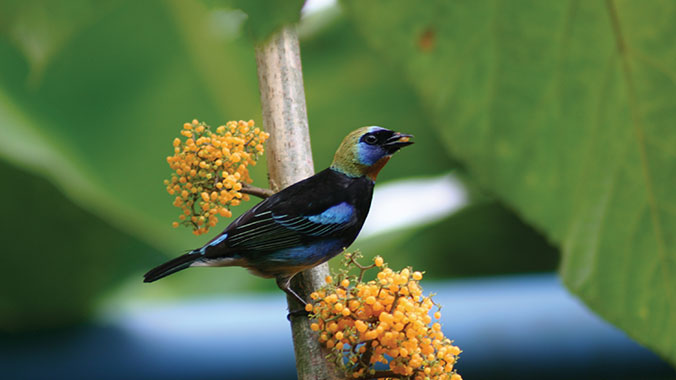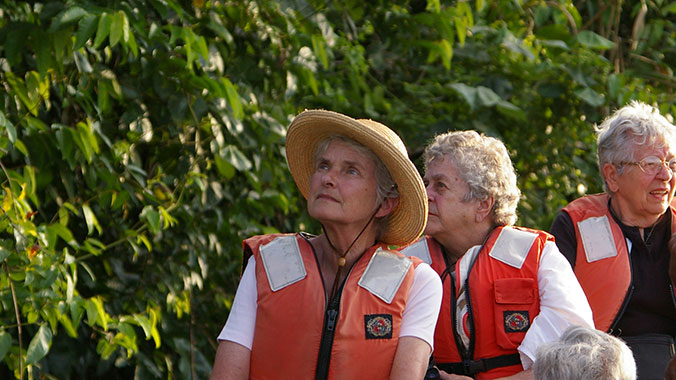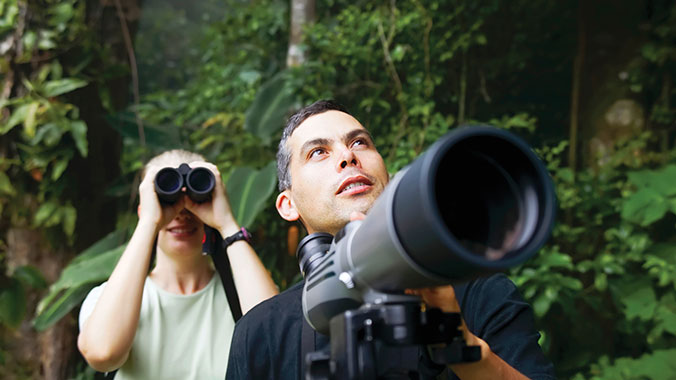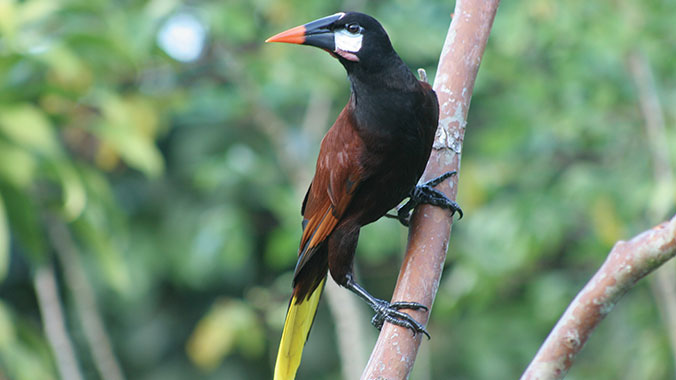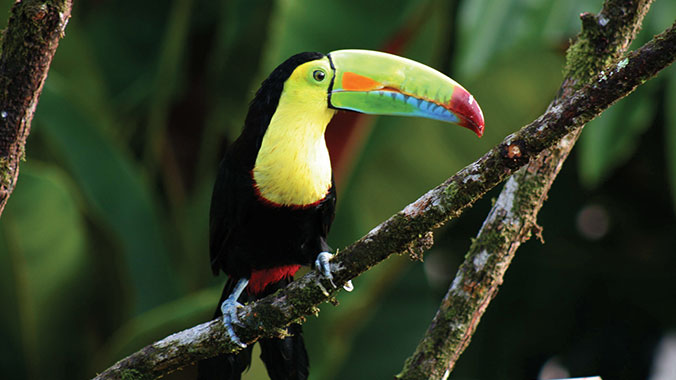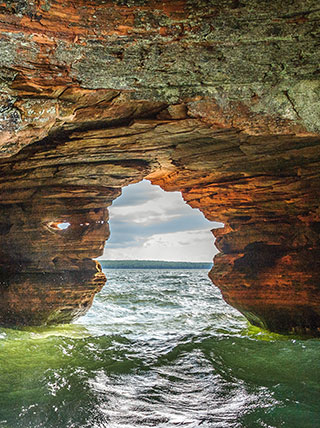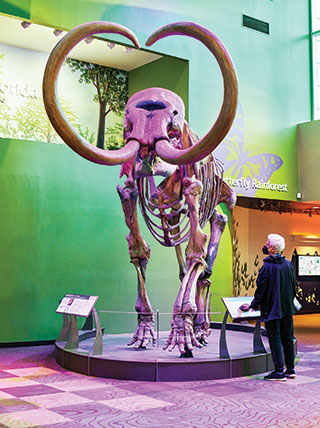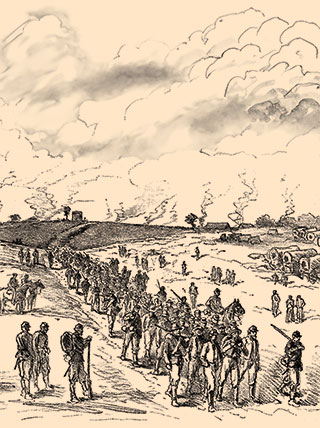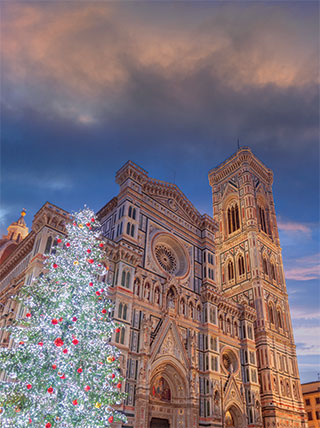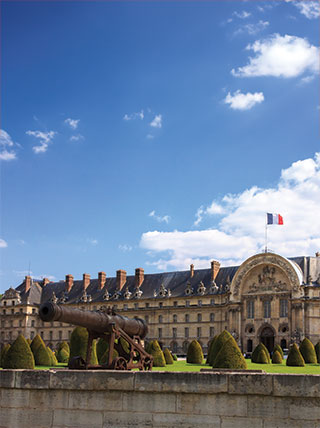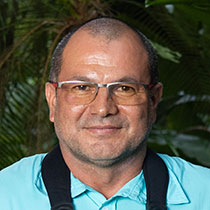
Birding in Northern Costa Rica: Tanagers to Toucans
Enroll with Confidence
We want your Road Scholar learning adventure to be something to look forward to—not worry about. Learn more
Protecting the Environment
We offset a portion of the emissions created by your travel. Learn more
At a Glance

What You'll Learn
- Search for Keel-billed Toucans and the endangered Great-green macaw at the La Selva Biological Field Station.
- Spot Mangrove Black Hawks and Mangrove Warblers on a boat ride through the mangrove swamps in the Gulf of Nicoya.
- Discover why Caño Negro is one of the few nesting spots for the endangered Jabiru Stork.
General Notes

Please note: This expert may not be available for every date of this program.

- 2024
- 2025
- Jan 07 - Jan 17
- Jan 12 - Jan 22
- Jan 14 - Jan 24
- Jan 20 - Jan 30
- Jan 28 - Feb 07
- Feb 05 - Feb 15
- Feb 09 - Feb 19
- Feb 13 - Feb 23
- Feb 26 - Mar 08
- Mar 05 - Mar 15
- Mar 13 - Mar 23
- Mar 21 - Mar 31
- Apr 24 - May 04
- May 11 - May 21
- Oct 15 - Oct 25
- Nov 04 - Nov 14
- Dec 03 - Dec 13
- Dec 11 - Dec 21
- 2024
- 2025
- Jan 07 - Jan 17
- Jan 12 - Jan 22
- Jan 14 - Jan 24
- Jan 20 - Jan 30
- Jan 28 - Feb 07
- Feb 05 - Feb 15
- Feb 09 - Feb 19
- Feb 13 - Feb 23
- Feb 26 - Mar 08
- Mar 05 - Mar 15
- Mar 13 - Mar 23
- Mar 21 - Mar 31
- Apr 24 - May 04
- May 11 - May 21
- Oct 15 - Oct 25
- Nov 04 - Nov 14
- Dec 03 - Dec 13
- Dec 11 - Dec 21
Activity note: Hotel check-in from 3:00 p.m. See your program’s “Getting There” information regarding transfers. Remember to bring your nametag (sent previously).
Afternoon: Orientation: 6:00 p.m. at the hotel. The Group Leader will greet everyone and lead introductions. We will review the up-to-date program schedule, discuss roles and responsibilities, logistics, safety guidelines, emergency procedures, and answer questions. The species and numbers of birds we see will depend on seasonality and local conditions at the time of the program. Information on elevation regarding sea level is included in the daily schedule as it relates to species of birds that may be present at specific elevations. Walking distances and times during birding field trips are variable due to factors such as birds in a given area, group size and general ability. Transfers to/from program activities will be by bus unless specified otherwise. Stops built into the schedule are generally every 1.5 to 2 hours of travel. Meals will feature local cuisine. Periods in the schedule designated as “Free time” and “At leisure” offer opportunities to do what you like and make your experience even more meaningful and memorable according to your personal preferences. The Group Leader will be happy to offer suggestions. Program activities, schedules, personnel, and indicated distances or times may change due to local circumstances/conditions. In the event of changes, we will alert you as quickly as possible. Thank you for your understanding.
Dinner: Welcome dinner at the hotel.
Evening: At leisure. Continue getting to know your fellow Road Scholars, settle in, and get a good night’s rest for the day ahead. Prepare for check-out and transfer in the morning.
Activity note: Getting on/off a bus; driving about 86 miles, approximately 3 hours riding time. Walking 1.5 to 2 miles; patchy forest with uneven, undulating terrain. Elevations up to 3,000 feet.
Breakfast: At the hotel.
Morning: We'll by joined by a local expert for an introduction to birding in Costa Rica. We’ll then check out of the hotel, board our bus, and set out on a relaxing ride to El Santuario La Ensenada, the wildlife refuge in the Gulf of Nicoya area. We expect to arrive in time for lunch and will check in to La Ensenada Lodge upon arrival.
Lunch: At the lodge.
Afternoon: Little used trails throughout the refuge make for excellent birding in the forest around the lodge. Around mid-afternoon, we’ll head out looking for dry forest species such as the Turquoise-browed Motmot and the Black-headed Trogon. This region of northwestern Costa Rica is characterized by an endangered life zone known as semi-deciduous or Tropical Dry Forest. Prolonged periods with very little rain have determined not only the forest’s structure, but also adaptations and specializations of plant and bird life. This area has its own unique species and is important to thousands of resident and migratory birds. Ensenada Wildlife Refuge is a private refuge created to protect not only the Tropical Dry Forest, but also the natural lagoons, mangrove, and estuarine habitats connected to the Gulf of Nicoya.
Dinner: At the lodge.
Evening: We’ll venture into the reserve for nocturnal birding. Using powerful lights to spot eyes, we’ll look for species such as night hawks, screech owls, nightjars, potoos, and thick-knees.
Activity note: Early morning (pre-breakfast) birding on lodge grounds. Walking up to 1 mile, undulating trails. Getting on/off a bus; driving about 16 miles, approximately 1 hour riding time. Getting on/off a motor boat, on/off a tractor-pulled cart. Elevation approximately 180 feet above sea level.
Breakfast: At the lodge.
Morning: We will have an early morning (pre-breakfast) walk on the lodge grounds. For another fascinating kind of birding, we'll explore the Gulf of Nicoya by motor boat, navigating canals and inlets of mangrove swamps that offer great opportunities to observe shore birds and marine species. We might also see endemics such as the mangrove black hawk and mangrove warbler. We’ll ride back to the lodge at the end of our field trip.
Lunch: At the lodge.
Afternoon: Next, we’ll go on a tractor-pulled cart ride around the lodge grounds, observing grasslands, lagoons, and salt ponds that are ideal for spotting shorebirds such as stilts and sandpipers. We’ll pause at a lookout point on the grounds to watch a beautiful Costa Rica sunset, then return to freshen up and relax before dinner.
Dinner: At the lodge.
Evening: We will take a walk around the grounds with our Group Leader to see what kinds of bird life are present. Prepare for check out and transfer in the morning.
Activity note: Getting on/off a bus; driving about 85 miles, approximately 3.5 to 4 hours riding time. Walking up to 1 mile; uneven terrain. Elevation from 100 to 330 feet.
Breakfast: At the hotel.
Morning: After checking out, we will board our bus and ride to the Caño Negro area in the northern flat lands. Often described as Costa Rica’s Everglades, Caño Negro acts as an expansive drainage basin for numerous rivers in the country’s northern section. Like the Everglades, this large “water filter” attracts numerous species of birds and waterfowl and has been protected as a wildlife reserve. Much of the flooded estuary dries up during the dry season when many of the birds migrate, then return with the rains. Caño Negro’s most common visitors are birds.
Lunch: At a restaurant en route.
Afternoon: Arriving at the lodge, we'll check in and get our room assignments. We will continue our birding adventure with a walking field trip around the grounds to look for birds such as the Glossy Ibis, Black-necked Stilt, Neotropical Cormorants, American Anhinga, Northern Jacana, American Widgeon, Wood Stork, White Ibis, Black-bellied Tree Duck, Northern Shoveler, Snail Kite, Green-backed Heron, Roseate Spoonbill and Blue-winged Teal and possibly the Jabiru. This is one of the best places to see the Nicaraguan Grackle, whose only Costa Rican habitat is Caño Negro and other marshy areas just south of Lake Nicaragua.
Dinner: At the lodge.
Evening: At leisure. Enjoy a walk or simply relax.
Activity note: Getting on/off a bus. Early morning (pre-breakfast) boating field trip in Caño Negro lagoon. Getting in/out of small, flat-bottom boats in the wetlands, approximately 2.5 to 3 hours morning and afternoon. Walking up to 1 mile, uneven terrain.
Breakfast: At the lodge.
Morning: After a snack of coffee and cookies, we will take a short bus ride to the dock and board a boat for our early morning boating field trip through the wetlands. Our Group Leader will provide commentary on wetland bird species as we go. This remote, 22,000 acre tropical wetland teems with wildlife. Aboard our boat, we will explore a portion of Costa Rica considered by many to be the best example of Mesoamerican wetlands. As we glide along lagoons and canals, be on the lookout for some of the 350 species of birds found in the refuge, including the largest colony of Neotropic Cormorants in Costa Rica, a colony of Nicaraguan Grackle, and egrets, anhingas, Roseate Spoonbills and other waterfowl. We may also spot caiman, crocodiles, and monkeys. We’ll return to the lodge for breakfast, then head out on foot to bird for more species around the lodge grounds and surrounding area including the pasture lands close-by to our lodge. At the end of the activity, we will return to the lodge.
Lunch: At the lodge.
Afternoon: After lunch we’ll be joined by a local expert for a presentation that will provide insights into the Caño Negro Wildlife Refuge and Wetlands. Returning to the reserve, we will learn more about the importance of the wetlands as a habitat for birds during another boating field trip. Caño Negro is one of the country’s most important wetlands areas, protected by the Ramsar Convention, an international treaty for conserving and sustaining wetlands. Adding to the diverse local bird population, thousands of migratory birds return here annually, whether for a short stay or to winter over. Caño Negro is also one of the few nesting spots for the endangered Jabiru Stork. We’ll return to the hotel with time to freshen up and relax before dinner.
Dinner: At the lodge.
Evening: At leisure. Prepare for early morning activities, check out, and transfer.
Activity note: Getting on/off a bus; driving about 85 miles, approximately 3 hours riding time. Walking a couple of miles; birding trails in primary and secondary rainforest, undulating terrain, hot/humid conditions. Elevation at Sarapiquí approximately 220 feet.
Breakfast: At the lodge.
Morning: We will check out of the hotel, board our bus, and begin our transfer to Sarapiquí. Situated in the Caribbean lowlands, 40 miles from San José, Sarapiquí is one of the richest sites for birds in Middle America with well over 400 species recorded. Nearby, the La Selva Protection Zone and the Braulio Carrillo National Park form the only significant corridor of forest on the Caribbean slope linking the highlands with the lowlands — a corridor crucial to birds and animals that undertake seasonal altitudinal migrations. Upon arrival, we will check in and have an orientation to the lodge.
Lunch: At the lodge.
Afternoon: Next, we will accompany our Group Leader on a birding walk on lodge grounds in search of target species. Before dinner, we'll gather with a local expert for a lecture on the Great Green Macaw, and learn about it's success story.
Dinner: At the lodge.
Evening: We’ll walk around the lodge grounds with our Group Leader to look for nocturnal species. The rainforest comes alive after sunset with the calls of its nocturnal inhabitants. As we listen to the sounds, try to distinguish one from another. Frogs, owls, bats, tepezcuintles (pacas), moths, and various other creatures come out just as most of us are getting ready for bed.
Activity note: Getting on/off a bus: about 53 miles, approximately 2 hours riding time. Walking several miles; birding trails in primary and secondary rainforest, undulating terrain, hot/humid conditions. Elevation approximately 180 feet above sea level.
Breakfast: At La Selva Biological Station.
Morning: Early this morning we will set out on a field trip to the Organization for Tropical Studies (OTS) La Selva Biological Field Station. With our Group Leader, we’ll continue birding in this well-known preserve for Manakins, tanagers and flycatchers along La Selva’s easy, paved trails. La Selva was established in 1954 as a farm dedicated to the improvement of natural resources management through experimentation on mixed plantations. It was purchased in 1968 by the non-profit Organization for Tropical Studies (OTS) and declared a private biological reserve and station. It has become one of the most important sites in the world for tropical rain forest research. La Selva comprises 3,900 acres of tropical wet forests and other lands. A home for more than the half of the 886 species of birds in Costa Rica, the station is located within the tropical and pre-montane wet forest. The OTS consortium includes 63 universities and research institutions from Latin America, the U.S., and Australia.
Lunch: At a local restaurant.
Afternoon: Our next field trip will be to Copearte, a garden run by a local artist and photographer with a passion for nature. The grounds have been designed to maximize opportunities for birding and photography and feature ponds that attract aquatic species as well as blinds from which participants can observe birds. A local expert will lead our exploration around the grounds as we keep a look out for bird species that have been spotted on the grounds previously: Collared Aracari, Band-tailed Barbthroat, Black-crowned Antpitta, and Pied Puffbirds. We'll return to the lodge after completing our activities.
Dinner: At the lodge.
Evening: We’ll go on another night walk around the lodge grounds to look for nocturnal species. Prepare for check out and transfer in the morning.
Activity note: Early morning (pre-breakfast) birding on lodge grounds. Walking up to 2 miles; uneven, undulating terrain in primary and secondary tropical forests with volcanic soil. Getting on/off a bus; driving about 60 miles, approximately 2 to 2.5 hours (depending on local conditions). Elevations range from 2,405 feet near the lodge to 2,723 feet at La Fortuna Town.
Breakfast: At the lodge.
Morning: We will set out on an early morning (pre-breakfast) birding walk on lodge grounds. After checking out, we will board the bus and begin our ride to Arenal with birding stops en route. The foothills and mountains surrounding Arenal Volcano National Park form a lush natural corridor between the Tilaran Range highlands and the northern lowlands, providing excellent habitat for many tropical species of flora and fauna. The park itself consists of primary rainforest, while the volcano’s impressive and nearly perfect cone shape dominates the landscape. This was Costa Rica’s most active volcano, which began its present eruptive cycle in 1968 until 2010.
Lunch: At a restaurant en route.
Afternoon: We expect to arrive at the lodge in the early afternoon and stretch our legs with a birding walk on the lodge grounds. We may be able to spot species such as hummingbirds, including the Black-crested Coquette, White-necked Jacobin, Stripe-throated Hermit, Violet-headed Hummingbird, and possibly the Rufous-tailed Hummingbird. We’ll then return to the lodge for check in.
Dinner: At the lodge.
Evening: At leisure. Walk the grounds of the lodge or just relax. Prepare for early morning activities.
Activity note: Early morning (pre-breakfast) birding on lodge grounds. Getting on/off a bus; driving about 8 miles, approximately 1/2 hour to 1 hour. Walking a few miles; hanging bridges, rainforest trail conditions, uneven ascents/descents. Elevation approximately 2,460 feet.
Breakfast: At the lodge.
Morning: Early at the lodge, we will have coffee and cookies, then set out for a birding walk along grounds and trails. After breakfast, we will board our bus and ride to the Arenal Sky Walk Hanging Bridges for an expert-led walking field trip along the undulating “terrain” of suspension bridges that take us through the primary rainforest. We’ll have a bird’s eye view of this pristine natural reserve through the lush vegetation surrounding us. Among the bird species we might see are mixed flocks including Streak-crowned Antvireo, Slaty Antwren, Spotted Woodcreeper, White-fronted Nunbird, and Scarlet-rumped Caciques. Other birds often seen here include Keel-billed Motmot, Rufous Motmot, Purplish-backed Quail-Dove, Spotted Antbird and the Short-tailed Hawk. We’ll return to the lodge at the conclusion of our field trip.
Lunch: At the lodge.
Afternoon: We’ll ride towards Lake Arenal then we'll set off on foot in search of Keel-billed Motmots and White-fronted Nunbirds in surrounding areas.
Dinner: At the lodge.
Evening: At leisure. Prepare for check out and transfer in the morning.
Activity note: Early morning (pre-breakfast) birding on lodge grounds. Getting on/off a bus; about 83 miles, approximately 3 to 3.5 hours riding time. Walking on uneven forest trails.
Breakfast: At the lodge.
Morning: Early at the lodge, we will have coffee and cookies, then set out for a birding walk along grounds and trails. After breakfast and checking out, we'll board our bus and begin the drive back to San José. Along the way, we’ll make a stop at a local finca to do some birding and learn about a conservation project aimed at cloud forest conservation and restoration. We'll explore the misty trails and walk among epiphyte-laden trees, mosses, and ferns in search of the birds that call this unique and vulnerable environment, home. Then we'll return to the main house in time for lunch.
Lunch: At the finca we’ll enjoy a family-hosted meal.
Afternoon: We’ll reboard the bus and continue our ride to San José with expected late afternoon arrival. We’ll check in to the hotel with some time to freshen up and relax before dinner.
Dinner: At the hotel. Share favorite experiences with new Road Scholar friends during our farewell dinner and discuss the final bird count.
Evening: At leisure. Prepare for hotel check out and departure in the morning.
Activity note: Participants with independent travel arrangements and/or scheduled on later flights can keep their hotel rooms until check-out time on this day. Hotel check-out 11:00 a.m.
Breakfast: At the hotel (depending on departure times). This concludes our program.
Morning: If you are returning home, safe travels. If you are staying on independently, have a wonderful time. If you are transferring to another Road Scholar program, detailed instructions are included in your Information Packet for that program. We hope you enjoy Road Scholar learning adventures and look forward to having you on rewarding programs in the future. Don’t forget to join our Facebook page and follow us on Instagram. Best wishes for all your journeys!
Recommended For You


